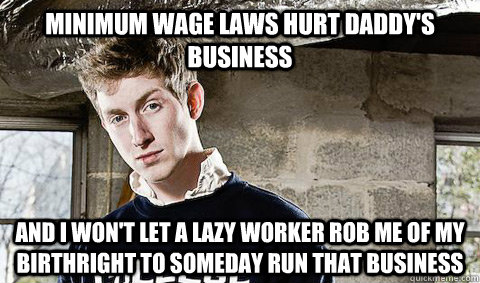Why must it always be the workers who pay?

The foundation of the Australian Federal Minimum Wage was the 1907 Harvester decision where Justice Higgins, President of the Commonwealth Court of Conciliation and Arbitration, quantified for the first time what was a ‘fair and reasonable’ wage for unskilled labour.
He approached the question by considering a wage which was appropriate to “the normal needs of the average employee regarded as a human being living in a civilised community”. He further articulated this as being a wage sufficient for “himself and his family” and as “a wage sufficient to insure the workman food, shelter, clothing, frugal comfort, provision for evil days, &c”.
In making his judgement Higgins drew upon a range of evidence which was presented in hearings – including by “working men’s wives and others” – on what might be the “necessary average weekly expenditure for a labourer’s home of about five persons”.
His view was that a business which could not afford to pay its workers a decent wage was not a viable proposition in the first place.
Over the years, this definition of the purpose of the minimum wage has been eroded. Effectively the changes have seen the minimum wage held constant in real terms with the role of support of the family being taken up by increases in government transfers for families with children and the decline of the single breadwinner family. In essence this has transformed the minimum wage to a wage for a single person with the state taking on the support for children.
Incidentally, it was not until 1975 that the minimum wage was applied to female workers, Gough’s legacy not only allowing Australians to be Australian, but women to be recognised as people.
Between September 1983 and July 1995 under a series of seven ‘Prices and Incomes Accords’ between the ACTU and the federal Labor Government there were a series of negotiated trade-offs of wage increases in favour of social wage benefits. These included: personal income tax cuts; child care subsidies; increased family payments; health care through Medicare; and the development of employer funded superannuation.
While most of these policies involved government expenditure (or reduced revenue as a result of tax cuts) as a trade-off for wage restraint, this was not the case with superannuation. The first stage of this was implemented in the 1986 National Wage Case which, in lieu of granting a wage increase for productivity gains, agreed a proposal for an employer contribution to superannuation of an amount equal to 3 per cent of wages for those workers employed under awards.
With the government talking about reform in areas such as industrial relations, the gender gap in superannuation, and raising the retirement age to 70, they must consider both the history and the interplay of policy on the goals they are trying to achieve.
Many of our workplace entitlements came as a trade- off for wage restraint and social policy. So when the Productivity Commission talks about winding back the minimum wage and penalty rates, and the Social Services Minister wants to reduce family payments, and the Health Minister tries to introduce co-payments, the worker is bearing the brunt of cuts they have already paid for.
Their concern about women having less superannuation is belied by their actions of rolling back the low income co-contribution and freezing the superannuation guarantee. The Coalition have always fought against employer contributions to superannuation but are very happy to give wealthy people, who were never going to qualify for the aged pension, the opportunity to minimise their tax.
As they talk about crises in both aged and child care, in suggesting we work till 70, they ignore the role that many people in their 60s play as carers. They facilitate their children re-entering the workforce and their parents remaining in their own homes for longer. They may even be caring for their partners as well. Carers’ allowance is a wise economic investment.
Prior to the Harvester decision back in 1907, it was parliament which decided that there should be a tariff exemption to employers who paid a “fair and reasonable” wage.
Perhaps, instead of stripping workers’ entitlements and cutting company tax for those who already don’t pay their fair share, we should revisit that idea of rewarding employers who do the right thing – those who recognise their obligations in the social contract, those who understand the urgency of sustainable production and waste management, those who pay their workers a wage appropriate to “the normal needs of the average employee regarded as a human being living in a civilised community”.
Like what we do at The AIMN?
You’ll like it even more knowing that your donation will help us to keep up the good fight.
Chuck in a few bucks and see just how far it goes!
Your contribution to help with the running costs of this site will be gratefully accepted.
You can donate through PayPal or credit card via the button below, or donate via bank transfer: BSB: 062500; A/c no: 10495969









